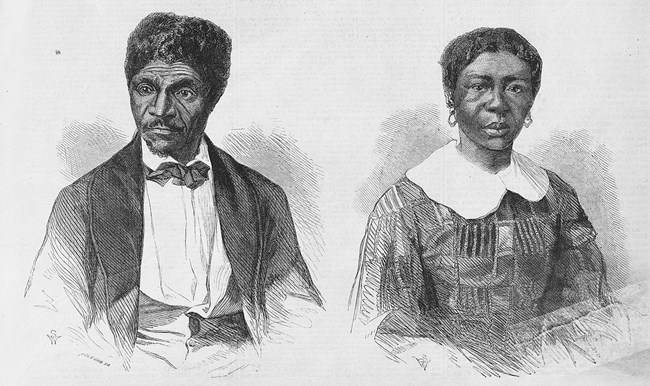
Dred and Harriet Scott took their future into their own hands in 1846 and came to the Old Courthouse to seek freedom from enslavement. Dred Scott was about 50 years old when the case began. He was born into enslavement in Virginia around 1799, as property of the Peter Blow family. The Blow family moved to St. Louis in 1830 taking Scott with them and soon sold him due to the family’s financial problems. Dr. John Emerson, a military surgeon stationed at Jefferson Barracks, purchased Scott and Scott accompanied him to posts in Illinois and the Wisconsin Territory, where slavery had been prohibited by the Missouri Compromise of 1820. During this period, Scott married Harriet Robinson, also enslaved, at Fort Snelling. They had two children, Eliza and Lizzie. John Emerson married Irene Sanford during a brief stay in Louisiana. In 1842, the Scotts returned with Dr. and Mrs. Emerson to St. Louis, where Dr. Emerson died the following year. Mrs. Emerson hired out Dred, Harriet and the Scott children to work for other families keeping the majority of their wages. On April 6th, 1846, Dred Scott and his wife Harriet filed suit against Irene Emerson for their freedom. It is not known for sure why he chose this particular time for the suit- for almost nine years, Scott had lived in free territories and had the standing to legally challenge his enslavement. Historians have considered three possibilities: He may have been dissatisfied with being hired out; Mrs. Emerson might have been planning to sell him; or he may have offered to buy his own freedom and been refused. It is known that the suit was not brought for political reasons. It is thought that friends in St. Louis who opposed slavery had encouraged Scott to sue for his freedom on the grounds that he had once lived in a free territory. In the past, Missouri courts supported the doctrine of "once free, always free." Because Scott lived under a system where it was illegal to teach an enslaved person to read or write he was illiterate and because his earnings were passed on to Mrs. Emerson he had no funds, he needed help with his suit. John Anderson, the Scott's minister, may have been influential in their decision to sue, and the Blow family, Dred's original owners, backed him financially. The support of such friends helped the Scotts through nearly eleven years of complex and often disappointing litigation. Under the law of 1846, the issue considered by the court system was not whether all humans have the right to freedom, but a question of property rights. In spite of this manifest injustice, Dred and Harriet Scott and 300 other enslaved people found the courage to come to the Old Courthouse seeking freedom. The Scott family didn’t find the freedom they sought through the legal challenge, but their courage and determination in filling this case helped bring about the Civil War and freedom from enslavement for all Americans.
Learn more by using these links:
|
An official website of the United States government
Here's how you know
Official websites use .gov
A
.gov website belongs to an official government
organization in the United States.
Secure .gov websites use HTTPS
A
lock (
) or https:// means you've safely connected to
the .gov website. Share sensitive information only on official,
secure websites.

